Balbharti Maharashtra State Board Class 9 History Solutions Chapter 7 Science and Technology Notes, Textbook Exercise Important Questions and Answers.
Science and Technology Class 9 Questions And Answers Maharashtra Board
Class 9 History Chapter 7 Science and Technology Questions And Answers Maharashtra Board
History Class 9 Chapter 7 Question Answer Maharashtra Board
1.A Choose the right option and rewrite the sentence:
Question 1.
_______ was named as the first Chairman of Atomic Energy Commission.
(a) Dr Homi Bhabha
(b) Dr Homi Sethna
(c) Dr A.P.J. Abdul Kalam
(d) Dr Raja Ramanna
Answer:
(a) Dr Homi Bhabha
Question 2.
________ was the first completely indigenous communication satellite made by ISRO.
(a) Aryabhatta
(b) Insat 1 B
(c) Rohini-75
(d) APPLE
Answer:
(d) APPLE
![]()
B. Identify the wrong pair:
Question 1.
(1) Prithvi – Surface-to-Surface ballistic missile
(2) Agni – Surface-to-Sea ballistic missile
(3) Akash – Surface-to-Air missile
(4) Nag – anti-tank missile
Answer:
Wrong Pair: Agni – Surface-to-Sea ballistic missile
2A. Prepare a timeline of the progress of India in science and technology:
Question .1

Answer:

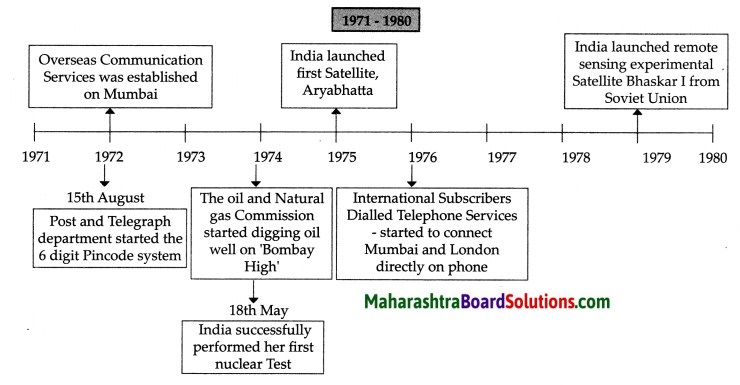
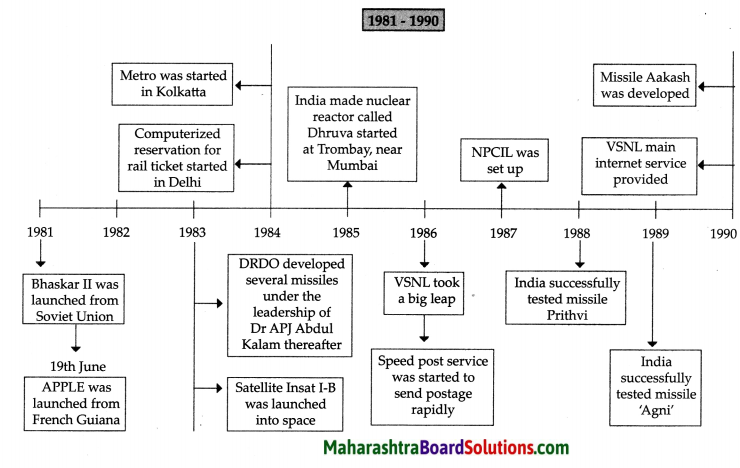

B. Explain the following concepts:
Question 1.
Space research
Answer:
(i) In 1961, Indian National Committee for Space Research (NCSR) launched India’s first research rocket from Thumba Equatorial Launch Centre in Thumba in the State of Kerala.
(ii) In 1969, our indigenously built rocket Rohini-75 was successfully launched.
(iii) The next stage was the successful launch of the first Indian satellite Aryabhatta in 1975 with help from the Soviet Union.
(iv) This success proved that Indian scientists can indigenously build and launch a satellite. Indian scientists were confident that they could acquire the technology for sending a message from the Earth Station and to assess the working of the satellite.
![]()
Question 2.
Telex service
Answer:
(i) The department of telecommunications under the Ministry of Communications started the telex service in 1963 to transmit typed messages from one part of the country to another rapidly.
(ii) In 1969, the telex service started in Devanagari script in Delhi.
(iii) Later, it spread all over the country.
(iv) This service began to be used in different fields. With the rise of internet after 1990, the significance of this service reduced.
3. Explain the following with reasons:
Question 1.
Pandit Nehru established the Atomic Energy Commission.
Answer:
(i) India’s first Prime Minister Pandit Jawaharlal Nehru wanted to nurture a scientific temper and bring about the nation’s progress.
(ii) From this perspective, he set up the Indian Atomic Energy Commission on 10th August, 1948.
(iii) Dr Homi Bhabha was appointed as the first Chairman of the Commission.
(iv) The objectives of the commission were to produce electricity from atomic energy, increase the yield of food grains and make them last longer, set up the technology for achieving this and develop nanotechnology.
Question 2.
India decided to conduct nuclear tests.
Answer:
(i) India successfully performed her first nuclear test at Pokharan in Rajasthan on 18th May, 1974 in consonance with the policy of using nuclear energy for peaceful purposes and for self sufficiency.
(ii) The reason why India took this decision was China’s nuclear capability and Pakistan’s desperate efforts to acquire nuclear weapons with China’s help.
(iii) Dr Homi Sethna, the chairman of the Indian Atomic Energy Commission and Dr Raja Ramanna, Director of the Bhabha Atomic Research Centre played a major role in conducting this nuclear test.
(iv) Prime Minister Indira Gandhi took the decision of carrying out a ‘nuclear explosion’. Pokharan was chosen on the basis of the required criteria for the location of the nuclear tests : far away from human settlement and no ground water reserves.
Question 3.
USA imposed economic sanctions on India.
Answer:
(i) On 11th May 1998, India carried out its second nuclear test to prove its nuclear preparedness.
(ii) Three tests were done on this day.
(iii) One of them was of the hydrogen bomb.
(iv) Prime Minister Atal Bihari Vajpayee assured that there would be no first use of nuclear weapons by India. But the USA imposed economic sanctions on India immediately.
4. Write the answers in 25 to 30 words:
Question 1.
Write about Pokharan nuclear test.
Answer:
(i) India successfully performed her first nuclear test at Pokharan in Rajasthan on 18th May, 1974 in consonance with the policy of using nuclear energy for peaceful purposes and for self-sufficiency.
(ii) The reason why India took this decision was China’s nuclear capability and Pakistan’s desperate efforts to acquire nuclear weapons with China’s help.
(iii) Dr Homi Sethna, the chairman of the Indian Atomic Energy Commission and Dr Raja Ramanna, Director of the Bhabha Atomic Research Centre played a major role in conducting this nuclear test.
(iv) Prime Minister Indira Gandhi took the decision of carrying out a ‘nuclear explosion’. Pokharan was chosen on the basis of the required criteria for the location of the nuclear tests: far away from human settlement and no groundwater reserve.
Question 2.
For which sector was Bhaskar-1 satellite expected to be useful?
Answer:
(i) India launched remote sensing experimental satellite Bhaskar-1 from the Soviet Union in 1979 in order to observe various things on the surface of the Earth by remote sensing technology.
(ii) This remote sensing technology would be useful for India’s development by regarding water bodies, mineral deposits and forecasting weather.
(iii) The photographs taken with the help of this technology about the bowels of the Earth, environment and forests were important.
(iv) Another area in which the information from this satellite was useful was Oceanography
![]()
5. Write in brief:
Question 1.
Which of the everyday services are influenced by satellite technology?
Answer:
(i) Bhaskar-1: India launched remote sensing experimental satellite Bhaskar-1 from the Soviet Union in 1979 in order to observe various things on the surface of the Earth by remote sensing technology. This remote sensing technology would be useful for India’s development by regarding water bodies, mineral deposits and forecasting weather. The photographs taken with the help of this technology about the bowels of the Earth, environment and forests were important. Another area in which the information from this satellite was useful was Oceanography. In 1981, ‘Bhaskar-2’ was launched from Soviet Union.
(ii) (if APPLE (Ariane Passenger Payload Experiment): The first completely indigenously built satellite by ISRO in India, APPLE was launched on 19th June, 1981 from the French Guiana. ‘APPLE’ was beneficial in the field of education. The objective of providing emergency telecommunication services was successful.
(iii) Indian National Satellite (INSAT): In August 1983, the satellite INSAT 1-B was launched in space. Because of this satellite, a major revolution came about in the areas of telecommunication, television, radio, weather forecasting and space research in India. Due to INSAT, 207 Akashwani or Radio stations could be connected to each other. This mechanism was also useful for search and rescue of people caught in some disaster like a shipwreck or an air plane crash, for forecasting weather, to look for and follow cyclones or storms, in the fields of telemedicine and educational institutions. The tele-medicine service enabled the population from remote areas to get advice and treatment from expert doctors. Public Primary Health Centers in villages have been connected with super speciality hospitals through INSAT.
(iv) Satellite Communication Centre: In order to establish satellite communication with the help of an artificial satellite, a domestic satellite communication Earth station was established in 1967, at Jodhpur Tekra near Ahmedabad. This made it easy to train scientists and technicians in setting up and running an Earth Station within the country. In 1970, a centre was established at Aarvi near Pune, equipped for international telecommunication service. The technology adopted by railways has a big role in the history of modern India.
Question 2.
Why is Dr. A.P.J. Abdul Kalam called as the ‘Missile Man’?
Answer:
(i) In 1958, Defence Research and Development Organisation (DRDO) was established under the Department of Defence of the government of India. The objective of this organisation was to make India self-sufficient with respect to means, equipment and weapons required for defence. After 1983, this organisation developed several missiles under the leadership of Dr. A.P.J. Abdul Kalam. Dr Kalam has made a great contribution in the production of missiles. Dr Kalam is known as the father of India’s missile programme. He is also referred to as the ‘Missile Man’ of India.
(ii) Integrated Guided Missile Development Programme (IGMDP) was conceived by and carried out under the leadership of Dr A.P.J. Abdul Kalam. Defence Research and Development organisation (DRDO) undertook the task of building the missiles.
Question 3.
How can one have computerized reservation done for railway travel?
Answer:
(i) There is a site called IRCTC for online railway bookings. On it’s site, sign up option is given through which Login Id and Password is created for IRCTC account. One must login with this ID and password for booking railway ticket. A captcha image needs to be filled to ensure the account is not being misused.
(ii) To the left of the page on the site, a column is given to enter the destination and boarding point, along with the date on which the journey is supposed to be made. After filling this, the list of trains along with their numbers, berth system, schedules is shown. The Quota, i.e. general, ladies, senior citizen needs to be filled here.
(iii) Here, if the ladies quota is selected, the berth is booked in the compartment reserved exclusively for ladies. If senior citizen quota is selected, exemption in travel fees is given.
(iv) After this, berth preferences i.e. sleeper, second seating is to be selected to book the tickets. Upon which, a new window opens for filling the details like name of the passenger, age, etc. A captcha image needs to be filled again to confirm booking.
(v) The gateway to online payment opens up which is done through Debit Card or Internet Banking, whichever is easier for the person booking it. A message of confirmation and email is received to the person booking it for his/her detail.
Question 4.
Write the key features of the Konkan Railway.
Answer:
(i) The Konkan Railway started in 1998.
(ii) There are several records of technology to the credit of Konkan Railway which stretches over the four states of Maharashtra, Goa, Karnataka and Kerala over a distance of 760 kilometres.
(iii) There are 12 tunnels on this track. The 6.5 km tunnel at Karbude is the longest tunnel. There are 179 big and 1819 small bridges on this track.
(iv) Out of these, the 2065.8 m long bridge on River Sharavati near Honnawar is the biggest, i.e. The 64 m tall bridge on River Panval near Ratnagiri is India’s tallest bridge.
(v) For avoiding accidents on tracks that are prone to landslides, there are sensors fitted to the railway engines.
Class 9 History Chapter 7 Science and Technology Additional Important Questions and Answers
Choose the correct option from the given options and rewrite the statements:
Question 1.
The Indian Atomic Energy Commission was set up on_______.
(a) 10th Aug, 1958
(b) 10th Aug, 1948
(c) 10th Aug, 1968
(d) 19th Aug, 1858
Answer:
(b) 10th Aug, 1948
![]()
Question 2.
In 1956, the Department of Atomic Energy set up _______, a nuclear reactor functioning on atomic energy.
(a) Syrus
(b) Zarlina
(c) Poornima
(d) Apsara
Answer:
(d) Apsara
Question 3.
India successfully performed her first nuclear test at ______.
(a) Pokhran
(b) Jaipur
(c) Delhi
(d) Haryana
Answer:
(a) Pokhran
Question 4.
Prime Minister _________ assured that there would be no first use of nuclear weapons by India.
(a) Pandit Jawaharlal Nehru
(b) Atal Bihari Vajpayee
(c) Indira Gandhi
(d) VP Singh
Answer:
(b) Atal Bihari Vajpayee
Question 5.
The first digit of the pincode indicates the ______.
(a) State
(b) Region
(c) Nation
(d) District
Answer:
(b) Region
Question 6.
Agni had a range of ________ km.
(a) 800
(b) 600
(c) 700
(d) 500
Answer:
(c) 700
Question 7.
In 1981, ‘Bhaskar-2’ was launched from _______ .
(a) Soviet Union
(b) Japan
(c) China
(d) America
Answer:
(a) Soviet Union
Question 8.
_____a surface to surface ballistic missile was given to the Army.
(a) Prithvi -1
(b) Prithvi – 2
(c) Prithvi – 3
(d) Agni
Answer:
(a) Prithvi -1
![]()
Question 9.
APPLE’ was beneficial in the field of _______.
(a) Military
(b) Education
(c) Health
(d) Technology
Answer:
(b) Education
Question 10.
In _________ the telecommunication department was restructured.
(a) 1991
(b) 2000
(c) 2002
(d) 1880
Answer:
(b) 2000
Question 11.
Konkan railway started in the year _______.
(a) 1888
(b) 1988
(c) 1998
(d) 1994
Answer:
(c) 1998
Question 12.
On,________ the mobile phone service started in India.
(a) 23rd Aug, 1994
(b) 22nd Aug, 1994
(c) 24th Aug, 1994
(d) 21st Aug, 1994
Answer:
(b) 22nd Aug, 1994
Question 13.
In 1970, a domestic satellite communication earth centre was established at Aarvi near _______, equipped for international telecommunication service.
(a) Mumbai
(b) Pune
(c) Nagpur
(d) Nashik
Answer:
(b) Pune
Identify and write the wrong pair from the following sets:
Question 1.
(1) Dr. Homi Sethna – Chairman of DRDO
(2) Dr. Raja Ramanna – Director of BARC
(3) Sam Pitroda – Spearheaded telecommunication
(4) Dr. A.P.J. Abdul Kalam – Conceived and Carried out IGMDP
Answer:
Wrong Pair : Dr. Homi Sethna – Chairman of DRDO
Question 2.
(1) First diesel engine – Diesel Locomotive Works at Varanasi
(2) India’s tallest bridge – at Karbude
(3) Completely Indian made nuclear reactor – Dhruva at Trombay
(4) India’s first research rocket – Thumba Equatorial Launch Centre at Kerala.
Answer:
Wrong Pair : India’s tallest bridge – at Karbude
![]()
Question 3.
(1) Indigenously built rocket – Rohini 75
(2) First Indian Satellite – Aryabhatta
(3) Headquarters of ISRO – Sriharikota
(4) Reactor research Centre – Kalpakkam
Answer:
Wrong Pair: Headquarters of ISRO – Sriharikota
Question 4.
(1) NPCIL – setup in 1987
(2) Bhaskar – 2 – launched in 1981
(3) ONGC – established in 1998
(4) Tarapur power station – Setup in 1969
Answer:
Wrong Pair : ONGC – established in 1998
Question 5.
(1) Post and Telegraph Department started the 6 digit pincode system – 15th August 1972
(2) Indian Atomic Energy Commission was setup – 10th August 1948
(3) Indian Space Research Organisation was established – 15th August 1959
(4) First Nuclear test at Pokhran – 18th May 1974
Answer:
Wrong Pair: Indian Space Research Organisation was established – 15th August 1959
Question 6.
(1) Domestic Satellite Communication Earth Centre – Jodhpur Tekra
(2) Space station to launch satellites – Sriharikota
(3) Mineral Oil Deposit – Digboi in Assam
(4) Factories manufacturing Heavy Water – Chittaranjan in Bardwan
Answer:
Wrong Pair : Factories manufacturing Heavy Water – Chittaranjan in Bardwan
Question 7.
(1) Satellite built by ISRO – APPLE
(2) Satellite to connect super speciality hospitals – INSAT
(3) Remote sensing experimental satellite – Bhaskar -1
(4) First Indian Satellite – Rohini – 75
Answer:
Wrong Pair : First Indian Satellite – Rohini – 75
Question 8.
(1) INSAT, 1-B was launched – August 1983
(2) APPLE was launched – June 1981
(3) Mobile services started – August 1994
(4) Second Nuclear test – June 1998
Answer:
Wrong Pair : Second Nuclear test – June 1998
Question 9.
(1) Telex services started in Devanagari Script -1969
(2) India successfully tested missile Agni -1989
(3) Computerised reservation started in Delhi -1986
(4) Satellite Communication Centre established at Aarvi, Pune -1970
Answer:
Wrong Pair : Computerised reservation started in Delhi -1986
![]()
Write short notes:
Question 1.
Pincode
Answer:
(i) From 15 August 1972, the Post and Telegraph Department started the six digit pincode system in the country.
(ii) The Postal Index Code was intended to bring efficiency in distributing the mail. In this system, the country was divided into nine regions.
(iii) The first digit of the Pincode indicates the region, the second digit indicates the Sub¬region, the third digit shows the main disbursement district, while the remaining three digits show the location of the local post office.
(iv) For Maharashtra, 40, 41, 42, 43, 44 are the first two digits. In 1986, the speed post service was started to send postage rapidly.
Question 2.
Akash and Nag missiles
Answer:
(i) In 1990, the missile Akash was developed to fire from land into air.
(ii) This missile has a capacity to carry 720 kilogram explosives at supersonic speed and a range of 30 kilometres.
(iii) The missile ‘Nag’ was made in order to destroy the tanks of the enemy.
(iv) It is of the ‘fire and forget’ type. India has militarily become secure due to the production of missiles.
Question 3.
Bharat Sanchar Nigam Limited (BSNL)
Answer:
(i) In 2000, the telecommunication department was restructured.
(ii) The responsibility to make policy decisions was retained with the Telecom Department.
(iii) Bharat Sanchar Nigam Limited was established to actually provide the services to consumers.
(iv) Along with the telephone service, cellular phone, internet, broadband services were also made available.
Question 4.
Dhruva Nuclear Reactor
Answer:
(i) In 1985, a completely Indian made nuclear reactor called Dhruva was started at Trombay near Mumbai.
(ii) The Dhruva nuclear reactor uses uranium as fuel.
(iii) At this center, 350 radioactive substances are produced. They are used in industry, agriculture and medicine.
Question 5.
Nuclear Power Corporation of India Ltd. (NPCIL)
Answer:
(i) This Company was set up in 1987 to generate electricity from atomic energy.
(ii) The objective of the company is to master and develop the technology to generate safe, cheap and environmentally profitable power and make the country self-sufficient.
Question 6.
DRDO was established.
Answer:
(i) In 1958, Defence Research and Development Organisation (DRDO) was established under the Department of Defence of the Government of India.
(ii) The objective of this organisation was to make India self-sufficient with respect to means, equipment and weapons required for defence.
(iii) After 1983, this organisation developed several missiles under the leadership of Dr A.P.J. Abdul Kalam. Dr Kalam has made a great contribution in the production of missiles.
(iv) Dr Kalam is known as the Father of India’s Missile Programme. He is also referred to as the ‘Missile Man’ of India.
![]()
Read the passage and answer the questions:
Passage I
Space research: In 1961, Indian National Committee for Space Research (NCSR) launched India’s first , research rocket from Thumba Equatorial Launch Center in Thumba in the State of Kerala. In 1969, our indigenously built rocket Rohini-75 was successfully launched. The next stage was the successful launch , of the first Indian satellite Aryabhatta in 1975 with ‘ help from the Soviet Union. This success proved that Indian scientists can indigenously build and launch satellite. Indian scientists were confident that they , could acquire the technology for sending a message from the Earth Station and to assess the working of the satellite.
Indian Space Research Organisation (ISRO) : After , the success of the basic programme in space research and rocket related project, Indian Space Research Organisation was established on 15th August 1969 in order to carry out further space research. ‘ The headquarters of ISRO are at Bengaluru. ISRO activated the space station at Sriharikota in Andhra Pradesh for launching our satellites in space.
Bhaskar-1: India launched remote sensing ,experimental satellite Bhaskar-1 from the Soviet Union in 1979 in order to observe various things on the surface of the earth by remote sensing technology, This remote sensing technology would be useful for India’s development by regarding water bodies, mineral deposits and forecasting weather. The photographs taken with the help of this technology about the bowels of the earth, environment and forests were important. Another area in which the information from this satellite was useful was oceanography. In 1981, ‘Bhaskar-2’ was launched from Soviet Union.
Question 1.
What does the passage deal with?
Answer:
The passage deals with India’s success in space research.
Question 2.
Complete the following
Answer:
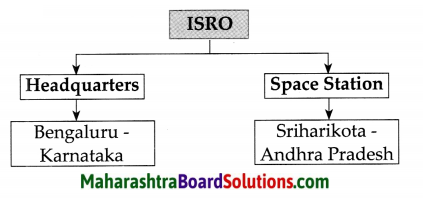
Question 3.
State the benefits of remote sensing technology.
Answer:
Following are the benefits of Remote Sensing Technology:
- Useful for India’s development by regarding water bodies mineral deposits and forecasting weather.
- Important information can be gathered about bowels of earth, environment and forests through the photograph.
- Useful information about Oceanography can be assessed.
![]()
Passage II
Oil and Natural Gas Commission (ONGC) : In 1956, the Oil and Natural Gas Commission was established to search for the deposits of mineral oil and natural gas and to increase their production. After Digboi in Assam, mineral oil deposits were found in Ankleshwar , area in Gujarat. Later, mineral oil and natural gas deposits were found in the gulf of Khambhat in Gujarat. In 1974, the Oil and Natural Gas Commission , started digging an oil well in ‘Bombay High’ area , with the help of Russian scientists by a drillship called ‘Sagar Samrat’. From 1975, mineral oil and natural gas began to be extracted from there. Later, more than 8500 oil wells and 33 natural gas wells dug eventually in this area began to contribute , 38% of the total mineral oil production in the country and met 14% of the country’s demand for crude oil.
Railways and Technology : The technology adopted by railways has a big role in the history of modem India. In order to bring efficiency, accuracy and coordination in the reservation system in rail travel, computerised reservation system was started for the first time in Delhi in 1984. In the same year, the Metro was started in Kolkata. In this way India has been making progress in the fields of science and technology. New inventions have been made. India is an important 21st century nation, which has always used technology for establishing peace in the world. India is making all these advancements in order to be the foremost among nations in the 21st century. In the next chapter, we shall learn about the progress India , has made in the fields of commerce and trade.
Question 1.
State the odd man out – and state the reason Digboi, Kohima, Ankleshwar, Bombay High
Answer:
Kohima – Because the other three locations of Digboi, Ankleshwar and Bombay High have notable reserves of natural gas and mineral oil
deposits.
Question 2.
Complete the following – Konkan Railway chart:
Answer:
| Established | 1998 |
| States Covered | Maharashtra, Goa, Karnataka Kerala. |
| Longest Tunnel | 6.5 km long tunnel at Karbude |
| Tallest Bridge | 64 mt. tall bridge on River Panvel near Ratnagiri |
Question 3.
Do you think we can rely on our mineral oil deposits for time to come? Justify your answer.
Answer:
Mineral Oil Deposits are fast depleting due to it’s indiscriminate consumption by industries. Such natural resources of energy should be spared through fuel conservation schemes and greater use of inexhaustible sources of energy such as – Tidal, Solar or Wind energy.
Since mineral oil deposits are not renewable source of energy, it is advisable not to rely on it for time to come or we may face energy crisis.
Answer the following questions in detail:
Question 1.
Write a note on the Indian Atomic Energy Commission.
Answer:
(i) In India’s first Prime Minister Pandit Jawaharlal Nehru wanted to nurture a scientific temper and bring about the nation’s progress. From this perspective, he set up the Indian Atomic Energy Commission on 10th August 1948. Dr. Homi Bhabha was appointed as the first Chairman of the Commission. The objectives of the commission were to produce electricity from atomic energy, increase the yield of food grains and make them last longer, set up the technology for achieving this and develop nanotechnology. In 1956, the Department of Atomic Energy set up ‘Apsara’, a nuclear reactor functioning on atomic energy.
(ii) In 1969, an atomic power station was set up at Tarapur. A Reactor Research Centre was set up at Kalpakkam in Tamil Nadu to successfully use Thorium for generating atomic power. The role of reactors is important in developing atomic power.
(iii) Factories manufacturing the heavy water needed for the generation of atomic power were set up at Vadodara, Talcher, Tutikorin, Kota, etc. An institution called Heavy Water Projects was set up to carry out research on manufacturing heavy water within the country. It was later renamed ‘Heavy Water Board’.
![]()
Question 2.
Write about ISD.
Answer:
(i) In 1972, Overseas Communication Service was established in Mumbai for the Management of International Telecommunication Service.
(ii) In 1976, the International Subscriber Dialled Telephone Service started to connect Mumbai and London directly on the phone.
(iii) Alongside the telephone service, services like telex, teleprinter and radio images started. In 1986, Videsh Sanchar Nigam Limited (VSNL) took a big leap in this field. Before that, Mahanagar Telephone Nigam Limited (MTNL) was a public sector company for giving telephone service in big cities.
(iv) In the 1990s, Videsh Sanchar Nigam Limited held the distinction of being the main internet service provider in India. The contribution of Sam Pitroda in this field is significant.
Question 3.
Write about Oil and Natural Gas Commission.
Answer:
(i) In 1956, the Oil and Natural Gas Commission was established to search for the deposits of mineral oil and natural gas and to increase their production.
(ii) After Digboi in Assam, mineral oil deposits were found in Ankleshwar area in Gujarat. Later, mineral oil and natural gas deposits were found in the gulf of Khambhat in Gujarat.
(iii) In 1974, the Oil and Natural Gas Commission started digging an oil well in ‘Bombay High’ area with the help of Russian scientists by a drillship called ‘Sagar Samrat’.
(iv) From 1975, mineral oil and natural gas began to be extracted from there.
(v) Later, more than 8500 oil wells and 33 natural gas wells dug eventually in this area began to contribute 38% of the total mineral oil production in the country and met 14% of the country’s demand for crude oil.
Observe the picture and write relevant information:
Question 1.
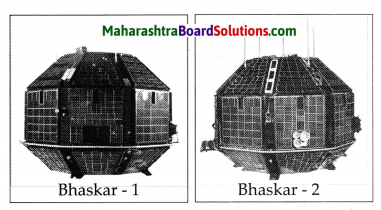
Answer:
Bhaskar 1 was a remote sensing experimental satellite launched by India.
Remote Sensing Technology would be useful for India’s development by regarding water bodies, mineral deposite and forecasting weather.
The photographs taken with the help of this technology about the bowels of the earth environment and forest were important. Bhaskar -1 was launched in 1979 and Bhaskar 2 was launched in 1981 from Soviet Union.
![]()
Question 2.
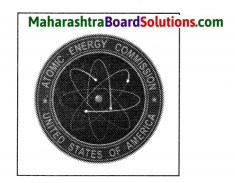
Answer:
Indian Atomic Energy Commission:
India’s first Prime Minister Pandit Jawaharlal Nehru wanted to nurture a scientific temper and bring about the nation’s progress. From this persepective, he set up the Indian Atomic Energy Commission on 10th August 1948. Dr. Homi Bhabha was appointed as the first Chairman of the Commission. The objectives of the Commission were to produce electricity from atomic energy, increase the yield of food grains and make them last longer, set up the technology for achieving this and develop nanotechnology.
Question 3.
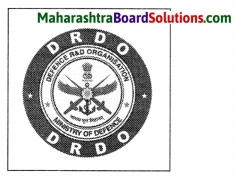
Answer:
In 1958, Defence Research and Development Organisation (DRDO) was established under the Department of Defence of the government of India. The objective of this organisation was to make India self-sufficient with respect to means, equipment and weapons required for defence. After 1983, this organisation developed several missiles under the leadership of Dr. A. P. J. Abdul Kalam. Dr. Kalam has made a great contribution in the production of missiles. Dr. Kalam is known as the ‘Father of India’s missile programme’. He is also referred to as the ‘Missile Man’ of India.
9th Std History Questions And Answers:
- Sources of History Class 9 History Questions And Answers
- India: Events After 1960 Class 9 History Questions And Answers
- India’s Internal Challenges Class 9 History Questions And Answers
- Economic Development Class 9 History Questions And Answers
- Education Class 9 History Questions And Answers
- Empowerment of Women and Other Weaker Sections Class 9 History Questions And Answers
- Science and Technology Class 9 History Questions And Answers
- Industry and Trade Class 9 History Questions And Answers
- Changing Life 1 Class 9 History Questions And Answers
- Changing Life 2 Class 9 History Questions And Answers